Performance Comparison between Densified and Undensified Silica Fume in Ultra-High Performance Fiber-Reinforced Concrete
Abstract
1. Introduction
2. Materials and Methods
2.1. Preparation of UHPFRC Samples
2.2. Experimental Methods
3. Results and Discussion
3.1. Observation of Agglomerated SF Particles
3.2. Material Properties of UHPFRC with Various Types of Silica Fume
3.3. Hydration Reaction of Heat-Treated UHPFRC with Various Types of Silica Fume
3.4. Feasibility of Using Densified Silica Fume in Field Casting UHPFRC
4. Conclusions
- Visual inspection and SEM image analysis confirmed that SF is composed of spherical nanoparticles, but, regardless of the type of SF product, they existed in the form of agglomerated lumps and the sizes of large ones reached several millimeters. The particle size analysis based on SEM images formed the size distribution in a smaller range compared to the results obtained by the DLS technique. The difference between the two techniques was attributed to the link of nanoparticles at a high temperature, the densification process or the agglomeration of nanoparticles thereafter, or the difference in dispersion efficiency during the ultrasonic treatment.
- The material properties of UHPFRC with densified and undensified SF were compared (their conditions other than the densification process were the same). Experimental results showed that there was no significant difference in workability, compressive strength, or flexural tensile strength between the two samples. Analysis of the hydration reaction based on XRD and TG also showed that there was almost no difference between the two samples in the formation or consumption of the main hydration products.
- When the samples were heat treated at 90 °C, portlandite was not identified because the chemical reaction related to the formation of this crystal was accelerated. This means that the pozzolanic reaction, which decisively affects the long-term strength and durability of the concrete, can be terminated significantly early due to the influence of limestone powder contained instead of Portland cement. Therefore, even when densified SF is used under standard heat treatment conditions, UHPFRC’s very high ultimate compressive strength (>200 MPa) can be ensured before 28 days.
- The results that the densified and undensified SFs did not differ in the hydration reaction and mechanical properties were also valid under air-dried curing conditions, without heat treatment. Thus, it was concluded that densified SF can be used for both precast and field casting UHPFRCs.
Author Contributions
Funding
Acknowledgments
Conflicts of Interest
References
- Richard, P.; Cheyrezy, M. Composition of reactive powder concretes. Cem. Concr. Res. 1995, 25, 1501–1511. [Google Scholar] [CrossRef]
- De Larrard, F.; Sedran, T. Optimization of ultra-high-performance concrete by the use of a packing model. Cem. Concr. Res. 1994, 24, 997–1009. [Google Scholar] [CrossRef]
- Brühwiler, E.; Denarié, E. Rehabilitation of concrete structures using ultra-high performance fibre reinforced concrete. In Proceedings of the Second International Symposium on Ultra High Performance Concrete, Kassel, Germany, 5–7 March 2008; pp. 895–902. [Google Scholar]
- Bastien-Masse, M.; Brühwiler, E. Experimental investigation on punching resistance of R-UHPFRC–RC composite slabs. Mater. Struct. 2016, 49, 1573–1590. [Google Scholar] [CrossRef]
- Schmidt, M.; Fehling, E. Ultra-high-performance concrete: Research, development and application in Europe. ACI Spec. Publ. 2005, 228, 51–78. [Google Scholar] [CrossRef]
- Wille, A.E.N.K.; Gustavo, J.P.-M. Ultra-high performance concrete with compressive strength exceeding 150 MPa (22 ksi): A simpler way. ACI Mater. J. 2011, 108. [Google Scholar] [CrossRef]
- Fontana, P.; Lehmann, C.; Müller, U.; Meng, B. Reactivity of mineral additions in autoclaved UHPC. In Proceedings of the International RILEM Conference on Material Science, Aachen, Germany, 6–8 September 2010; pp. 69–77. [Google Scholar]
- Huang, W.; Kazemi-Kamyab, H.; Sun, W.; Scrivener, K. Effect of replacement of silica fume with calcined clay on the hydration and microstructural development of eco-UHPFRC. Mater. Des. 2017, 121, 36–46. [Google Scholar] [CrossRef]
- Hafiz, M.A.; Skibsted, J.; Denarié, E. Influence of low curing temperatures on the tensile response of low clinker strain hardening UHPFRC under full restraint. Cem. Concr. Res. 2020, 128, 105940. [Google Scholar] [CrossRef]
- Ibrahim, M.A.; Farhat, M.; Issa, M.A.; Hasse, J.A. Effect of material constituents on mechanical and fracture mechanics properties of ultra-high-performance concrete. ACI Mater. J. 2017, 114, 453–465. [Google Scholar] [CrossRef]
- Zhang, X.; Zhao, S.; Liu, Z.; Wang, F. Utilization of steel slag in ultra-high performance concrete with enhanced eco-friendliness. Constr. Build. Mater. 2019, 214, 28–36. [Google Scholar] [CrossRef]
- Norhasri, M.S.M.; Hamidah, M.S.; Fadzil, A.M. Inclusion of nano metaclayed as additive in ultra high performance concrete (UHPC). Constr. Build. Mater. 2019, 201, 590–598. [Google Scholar] [CrossRef]
- Mo, Z.; Wang, R.; Gao, X. Hydration and mechanical properties of UHPC matrix containing limestone and different levels of metakaolin. Constr. Build. Mater. 2020, 256, 119454. [Google Scholar] [CrossRef]
- Yu, R.; Spiesz, P.; Brouwers, H.J.H. Development of an eco-friendly Ultra-High Performance Concrete (UHPC) with efficient cement and mineral admixtures uses. Cem. Concr. Compos. 2015, 55, 383–394. [Google Scholar] [CrossRef]
- Huang, W.; Kazemi-Kamyab, H.; Sun, W.; Scrivener, K. Effect of cement substitution by limestone on the hydration and microstructural development of ultra-high performance concrete (UHPC). Cem. Concr. Compos. 2017, 77, 86–101. [Google Scholar] [CrossRef]
- Kang, S.-H.; Jeong, Y.; Tan, K.H.; Moon, J. The use of limestone to replace physical filler of quartz powder in UHPFRC. Cem. Concr. Compos. 2018, 94, 238–247. [Google Scholar] [CrossRef]
- Kang, S.-H.; Jeong, Y.; Tan, K.H.; Moon, J. High-volume use of limestone in ultra-high performance fiber-reinforced concrete for reducing cement content and autogenous shrinkage. Constr. Build. Mater. 2019, 213, 292–305. [Google Scholar] [CrossRef]
- Li, P.P.; Brouwers, H.J.H.; Chen, W.; Yu, Q.L. Optimization and characterization of high-volume limestone powder in sustainable ultra-high performance concrete. Constr. Build. Mater. 2020, 242, 118112. [Google Scholar] [CrossRef]
- Li, P.P.; Yu, Q.L.; Brouwers, H.J.H.; Chen, W. Conceptual design and performance evaluation of two-stage ultra-low binder ultra-high performance concrete. Cem. Concr. Res. 2019, 125, 105858. [Google Scholar] [CrossRef]
- ACI Committee 234. Guide for the Use of Silica Fume in Concrete; American Concrete Institute: Farmington Hills, MI, USA, 2000; p. 51. [Google Scholar]
- Ahmad, S.; Mohaisen, K.O.; Adekunle, S.K.; Al-Dulaijan, S.U.; Maslehuddin, M. Influence of admixing natural pozzolan as partial replacement of cement and microsilica in UHPC mixtures. Constr. Build. Mater. 2019, 198, 437–444. [Google Scholar] [CrossRef]
- De Larrard, F. Ultrafine particles for the making of very high strength concretes. Cem. Concr. Res. 1989, 19, 161–172. [Google Scholar] [CrossRef]
- Fehling, E.; Schmidt, M.; Walraven, J.; Leutbecher, T.; Fröhlich, S. Ultra-High Performance Concrete UHPC: Fundamentals, Design, Examples; John Wiley & Sons: Hoboken, NJ, USA, 2014. [Google Scholar]
- Kang, S.-H.; Hong, S.-G.; Moon, J. The use of rice husk ash as reactive filler in ultra-high performance concrete. Cem. Concr. Res. 2019, 115, 389–400. [Google Scholar] [CrossRef]
- Oertel, T.; Hutter, F.; Tänzer, R.; Helbig, U.; Sextl, G. Primary particle size and agglomerate size effects of amorphous silica in ultra-high performance concrete. Cem. Concr. Compos. 2013, 37, 61–67. [Google Scholar] [CrossRef]
- Loukili, A.; Khelidj, A.; Richard, P. Hydration kinetics, change of relative humidity, and autogenous shrinkage of ultra-high-strength concrete. Cem. Concr. Res. 1999, 29, 577–584. [Google Scholar] [CrossRef]
- Siddique, R.; Khan, M.I. Supplementary Cementing Materials; Springer: Berlin/Heidelberg, Germany, 2011. [Google Scholar] [CrossRef]
- Chan, Y.-W.; Chu, S.-H. Effect of silica fume on steel fiber bond characteristics in reactive powder concrete. Cem. Concr. Res. 2004, 34, 1167–1172. [Google Scholar] [CrossRef]
- Holland, T.C. Silica Fume User’s Manual; Federal Highway Administration: Washington, DC, USA, 2005; p. 193.
- Lothenbach, B.; Scrivener, K.; Hooton, R.D. Supplementary cementitious materials. Cem. Concr. Res. 2011, 41, 1244–1256. [Google Scholar] [CrossRef]
- Pfeifer, C.; Moeser, B.; Weber, C.; Stark, J. Investigations of the pozzolanic reaction of silica fume in Ultra-high performance concrete (UHPC). In Proceedings of the International RILEM Conference on Material Science-MATSCI, Aachen, Germany, 6–8 September 2010; pp. 287–298. [Google Scholar]
- Oertel, T.; Hutter, F.; Helbig, U.; Sextl, G. Amorphous silica in ultra-high performance concrete: First hour of hydration. Cem. Concr. Res. 2014, 58, 131–142. [Google Scholar] [CrossRef]
- Van Tuan, N.; Ye, G.; van Breugel, K.; Copuroglu, O. Hydration and microstructure of ultra high performance concrete incorporating rice husk ash. Cem. Concr. Res. 2011, 41, 1104–1111. [Google Scholar] [CrossRef]
- St John, D.A. The Dispersion of Silica Fume; Industrial Research Ltd.: Lower Hutt, New Zealand, 1994; p. 29. [Google Scholar]
- Scrivener, K.; Young, J.F. Mechanisms of Chemical Degradation of Cement-Based Systems; E&FN Spon: London, UK, 1997. [Google Scholar]
- Pedro, D.; de Brito, J.; Evangelista, L. Evaluation of high-performance concrete with recycled aggregates: Use of densified silica fume as cement replacement. Constr. Build. Mater. 2017, 147, 803–814. [Google Scholar] [CrossRef]
- Bapat, J.D. Mineral Admixtures in Cement and Concrete; CRC Press: New York, NY, USA, 2012. [Google Scholar]
- Adil, G.; Kevern, J.T.; Mann, D. Influence of silica fume on mechanical and durability of pervious concrete. Constr. Build. Mater. 2020, 247, 118453. [Google Scholar] [CrossRef]
- St John, D.A.; McLeod, L.C.; Milestone, N.B. An Investigation of the Mixing and Properties of DSP Mortars Made from New Zealand Cements and Aggregates; Industrial Research Ltd.: Lower Hutt, New Zealand, 1993; p. 69. [Google Scholar]
- Diamond, S.; Sahu, S.; Thaulow, N. Reaction products of densified silica fume agglomerates in concrete. Cem. Concr. Res. 2004, 34, 1625–1632. [Google Scholar] [CrossRef]
- Diamond, S.; Sahu, S. Densified silica fume: Particle sizes and dispersion in concrete. Mater. Struct. 2006, 39, 849–859. [Google Scholar] [CrossRef]
- Kolderup, H. Particle size distribution of fumes formed by ferrosilicon production. J. Air Pollut. Control. Assoc. 1977, 27, 127–130. [Google Scholar] [CrossRef]
- Möser, B.; Pfeifer, C. Microstructure and durability of ultra-high performance concrete. In Proceedings of the Second International Symposium on Ultra High Performance Concrete, Kassel, Germany, 5–7 March 2008; pp. 417–424. [Google Scholar]
- Wang, X.; Huang, J.; Dai, S.; Ma, B.; Tan, H.; Jiang, Q. Effect of silica fume particle dispersion and distribution on the performance of cementitious materials: A theoretical analysis of optimal sonication treatment time. Constr. Build. Mater. 2019, 212, 549–560. [Google Scholar] [CrossRef]
- Arvaniti, E.C.; Juenger, M.C.G.; Bernal, S.A.; Duchesne, J.; Courard, L.; Leroy, S.; Provis, J.L.; Klemm, A.; De Belie, N. Determination of particle size, surface area, and shape of supplementary cementitious materials by different techniques. Mater. Struct. 2015, 48, 3687–3701. [Google Scholar] [CrossRef]
- Rodríguez, E.D.; Soriano, L.; Payá, J.; Borrachero, M.V.; Monzó, J.M. Increase of the reactivity of densified silica fume by sonication treatment. Ultrason. Sonochem. 2012, 19, 1099–1107. [Google Scholar] [CrossRef] [PubMed]
- Ma, R.; Guo, L.; Sun, W.; Rong, Z. Well-dispersed silica fume by surface modification and the control of cement hydration. Adv. Civ. Eng. 2018, 2018, 6184105. [Google Scholar] [CrossRef]
- Bianchi, G.Q. Application of Nano-Silica in Concrete. Ph.D. Thesis, Eindhoven University of Technology, Eindhoven, The Netherlands, 2014. [Google Scholar]
- Foerter-Barth, U.; Teipel, U. Characterization of particles by means of laser light diffraction and dynamic light scattering. In Developments in Mineral Processing; Massacci, P., Ed.; Elsevier: Amsterdam, The Netherlands, 2000; Volume 13, pp. C1-1–C1-8. [Google Scholar]
- Malm, A.V.; Corbett, J.C.W. Improved dynamic light scattering using an adaptive and statistically driven time resolved treatment of correlation data. Sci. Rep. 2019, 9, 13519. [Google Scholar] [CrossRef]
- Land, G.; Stephan, D. The influence of nano-silica on the hydration of ordinary Portland cement. J. Mater. Sci. 2012, 47, 1011–1017. [Google Scholar] [CrossRef]
- Lowke, D.; Schiessl, P. Effect of mixing energy on fresh properties of SCC. In Proceedings of the 4th International RILEM Symposium on Self-Compacting Concrete, Chicago, IL, USA, 30 October–2 November 2005; p. 6. [Google Scholar]
- Dils, J.; De Schutter, G.; Boel, V. Influence of mixing procedure and mixer type on fresh and hardened properties of concrete: A review. Mater. Struct. 2012, 45, 1673–1683. [Google Scholar] [CrossRef]
- ISO 13322-1:2014. Particle Size Analysis—Image Analysis Methods—Part 1: Static image analysis methods; International Organization for Standardization: Geneva, Switzerland, 2014; p. 24.
- ASTM C230/C230M-14. Standard Specification for Flow Table for Use in Tests of Hydraulic Cement; ASTM International: West Conshohocken, PA, USA, 2014. [CrossRef]
- ASTM C109/C109M-16a. Standard Test Method for Compressive Strength of Hydraulic Cement Mortars (Using 2-in. or [50-mm] Cube Specimens); ASTM International: West Conshohocken, PA, USA, 2016. [CrossRef]
- ISO 679. Cement–Test Methods–Determination of Strength; International Organization for Standardization: Geneva, Switzerland, 2009; p. 29.
- Scrivener, K.; Snellings, R.; Lothenbach, B. A Practical Guide to Microstructural Analysis of Cementitious Materials; CRC Press: Boca Raton, FL, USA, 2016. [Google Scholar]
- Snellings, R.; Chwast, J.; Cizer, Ö.; De Belie, N.; Dhandapani, Y.; Durdzinski, P.; Elsen, J.; Haufe, J.; Hooton, D.; Patapy, C.; et al. Report of TC 238-SCM: Hydration stoppage methods for phase assemblage studies of blended cements—Results of a round robin test. Mater. Struct. 2018, 51, 111. [Google Scholar] [CrossRef]
- Hewlett, P. Lea’s Chemistry of Cement and Concrete, 4th ed.; Butterworth-Heinemann: Oxford, UK, 2010. [Google Scholar]
- Kaasalainen, M.; Aseyev, V.; von Haartman, E.; Karaman, D.Ş.; Mäkilä, E.; Tenhu, H.; Rosenholm, J.; Salonen, J. Size, stability, and porosity of mesoporous nanoparticles characterized with light scattering. Nanoscale Res. Lett. 2017, 12, 74. [Google Scholar] [CrossRef]
- Snellings, R.; Mertens, G.; Elsen, J. Supplementary Cementitious Materials. Rev. Mineral. Geochem. 2012, 74, 211–278. [Google Scholar] [CrossRef]
- NF P18-470. Ultra-High Performance Fibre-Reinforced Concrete—Specifications, Performance, Production and Conformity; Association Française de Normalisation (AFNOR): Saint-Denis, France, 2016; p. 94.
- Sobolev, K.; Flores, I.; Hermosillo, R.; Torres-Martínez, L.M. Nanomaterials and nanotechnology for high-performance cement composites. In Proceedings of the ACI Session on Nanotechnology of Concrete: Recent Developments and Future Perspectives, Denver, CO, USA, 7 November 2006; pp. 91–118. [Google Scholar]
- Deshini, A.; Ioannides, A.M. Undispersed agglomerates and the strength of microsilica concrete. Int. J. Pavement Eng. 2012, 13, 226–234. [Google Scholar] [CrossRef]
- Lagerblad, B.; Utkin, P. Silica Granulates in Concrete: Dispersion and Durability Aspects; Cement och Betong Institutet: Stockholm, Sweeden, 1993; p. 44. [Google Scholar]
- Marusin, S.L.; Shotwell, L.B. Alkali-silica reaction in concrete caused by densified silica fume lumps: A case study. Cem. Concr. Aggreg. 2000, 22, 90–94. [Google Scholar] [CrossRef]
- Shayan, A.; Quick, G.W.; Lancucki, C.J. Morphological, mineralogical and chemical features of steam-cured concretes containing densified silica fume and various alkali levels. Adv. Cem. Res. 1993, 5, 151–162. [Google Scholar] [CrossRef]
- Baweja, T.C.D.; Bucea, L. Investigation of Dispersion Levels of Silica Fume in Pastes, Mortars, and Concrete; American Concrete Institute: Farmington Hills, MI, USA, 2003. [Google Scholar]
- Cao, Y.; Yu, Q.L.; Brouwers, H.J.H.; Chen, W. Predicting the rate effects on hooked-end fiber pullout performance from Ultra-High Performance Concrete (UHPC). Cem. Concr. Res. 2019, 120, 164–175. [Google Scholar] [CrossRef]
- Hafiz, M.A.; Denarié, E. Tensile response of UHPFRC under very low strain rates and low temperatures. Cem. Concr. Res. 2020, 133, 106067. [Google Scholar] [CrossRef]
- Kang, S.-H.; Lee, J.-H.; Hong, S.-G.; Moon, J. Microstructural investigation of heat-treated ultra-high performance concrete for optimum production. Materials 2017, 10, 1106. [Google Scholar] [CrossRef]
- Zhou, B.; Uchida, Y. Influence of flowability, casting time and formwork geometry on fiber orientation and mechanical properties of UHPFRC. Cem. Concr. Res. 2017, 95, 164–177. [Google Scholar] [CrossRef]
- Abrishambaf, A.; Pimentel, M.; Nunes, S. Influence of fibre orientation on the tensile behaviour of ultra-high performance fibre reinforced cementitious composites. Cem. Concr. Res. 2017, 97, 28–40. [Google Scholar] [CrossRef]
- Huang, H.; Gao, X.; Li, Y.; Su, A. SPH simulation and experimental investigation of fiber orientation in UHPC beams with different placements. Constr. Build. Mater. 2020, 233, 117372. [Google Scholar] [CrossRef]
- Larsen, I.L.; Thorstensen, R.T. The influence of steel fibres on compressive and tensile strength of ultra high performance concrete: A review. Constr. Build. Mater. 2020, 256, 119459. [Google Scholar] [CrossRef]
- Taylor, H.; Famy, C.; Scrivener, K. Delayed ettringite formation. Cem. Concr. Res. 2001, 31, 683–693. [Google Scholar] [CrossRef]
- Heinz, D.; Urbonas, L.; Gerlicher, T. Effect of heat treatment method on the properties of UHPC. In Proceedings of the 3rd International Symposium on Ultra High Performance Concrete and Nanotechnology for High Performance Construction Materials, Kassel, Germany, 7–9 March 2012; pp. 283–290. [Google Scholar]
- Jensen, O.M.; Hansen, P.F. Water-entrained cement-based materials: I. Principles and theoretical background. Cem. Concr. Res. 2001, 31, 647–654. [Google Scholar] [CrossRef]
- Justs, J.; Wyrzykowski, M.; Bajare, D.; Lura, P. Internal curing by superabsorbent polymers in ultra-high performance concrete. Cem. Concr. Res. 2015, 76, 82–90. [Google Scholar] [CrossRef]
- Heinz, D.; Ludwig, H.-M. Heat treatment and the risk of DEF delayed ettringite formation in UHPC. In Proceedings of the 1st International Symposium on Ultra-High Performance Concrete, Kassel, Germany, 13–15 September 2004; pp. 717–730. [Google Scholar]
- Selleng, C.; Meng, B.; Fontana, P. Phase composition and strength of thermally treated UHPC. In Proceedings of the 4th International Symposium on Ultra-High Performance Concrete and High Performance Materials, Kassel, Germany, 9–11 March 2016; pp. 7–8. [Google Scholar]
- Selleng, C.; Fontana, P.; Meng, B. Possibilities for improving the properties of UHPC by means of thermal treatment. In Proceedings of the AFGC-ACI-fib-RILEM PRO 106: Ultra-High Performance Fibre-Reinforced Concrete (UHPFRC 2017), Montpellier, France, 2–4 October 2017; pp. 83–92. [Google Scholar]
- Korpa, A.; Kowald, T.; Trettin, R. Phase development in normal and ultra high performance cementitious systems by quantitative X-ray analysis and thermoanalytical methods. Cem. Concr. Res. 2009, 39, 69–76. [Google Scholar] [CrossRef]
- Cheyrezy, M.; Maret, V.; Frouin, L. Microstructural analysis of RPC (Reactive Powder Concrete). Cem. Concr. Res. 1995, 25, 1491–1500. [Google Scholar] [CrossRef]
- Jensen, O.M.; Hansen, P.F. Influence of temperature on autogenous deformation and relative humidity change in hardening cement paste. Cem. Concr. Res. 1999, 29, 567–575. [Google Scholar] [CrossRef]
- Alexander, G.B.; Heston, W.M.; Iler, R.K. The solubility of amorphous silica in water. J. Phys. Chem. 1954, 58, 453–455. [Google Scholar] [CrossRef]
- Zhang, M.-H.; Gjørv, O.E. Effect of silica fume on cement hydration in low porosity cement pastes. Cem. Concr. Res. 1991, 21, 800–808. [Google Scholar] [CrossRef]
- Schachinger, I.; Hilbig, H.; Stengel, T. Effect of curing temperature at an early age on the long-term strength development of UHPC. In Proceedings of the Second International Symposium on Ultra High Performance Concrete, Kassel, Germany, 5–7 March 2008; pp. 205–212. [Google Scholar]
- Chung, D.D.L. Review: Improving cement-based materials by using silica fume. J. Mater. Sci. 2002, 37, 673–682. [Google Scholar] [CrossRef]
- Talayeh, N.; Eugen, B. Experimental investigation on reinforced ultra-high-performance fiber-reinforced concrete composite beams subjected to combined bending and shear. ACI Struct. J. 2013, 110, 251–261. [Google Scholar] [CrossRef]
- Lampropoulos, A.P.; Paschalis, S.A.; Tsioulou, O.T.; Dritsos, S.E. Strengthening of reinforced concrete beams using ultra high performance fibre reinforced concrete (UHPFRC). Eng. Struct. 2016, 106, 370–384. [Google Scholar] [CrossRef]
- Ford, E.L.; Hoover, C.G.; Mobasher, B.; Neithalath, N. Relating the nano-mechanical response and qualitative chemical maps of multi-component ultra-high performance cementitious binders. Constr. Build. Mater. 2020, 260, 119959. [Google Scholar] [CrossRef]
- Ali Dadvar, S.; Mostofinejad, D.; Bahmani, H. Strengthening of RC columns by ultra-high performance fiber reinforced concrete (UHPFRC) jacketing. Constr. Build. Mater. 2020, 235, 117485. [Google Scholar] [CrossRef]
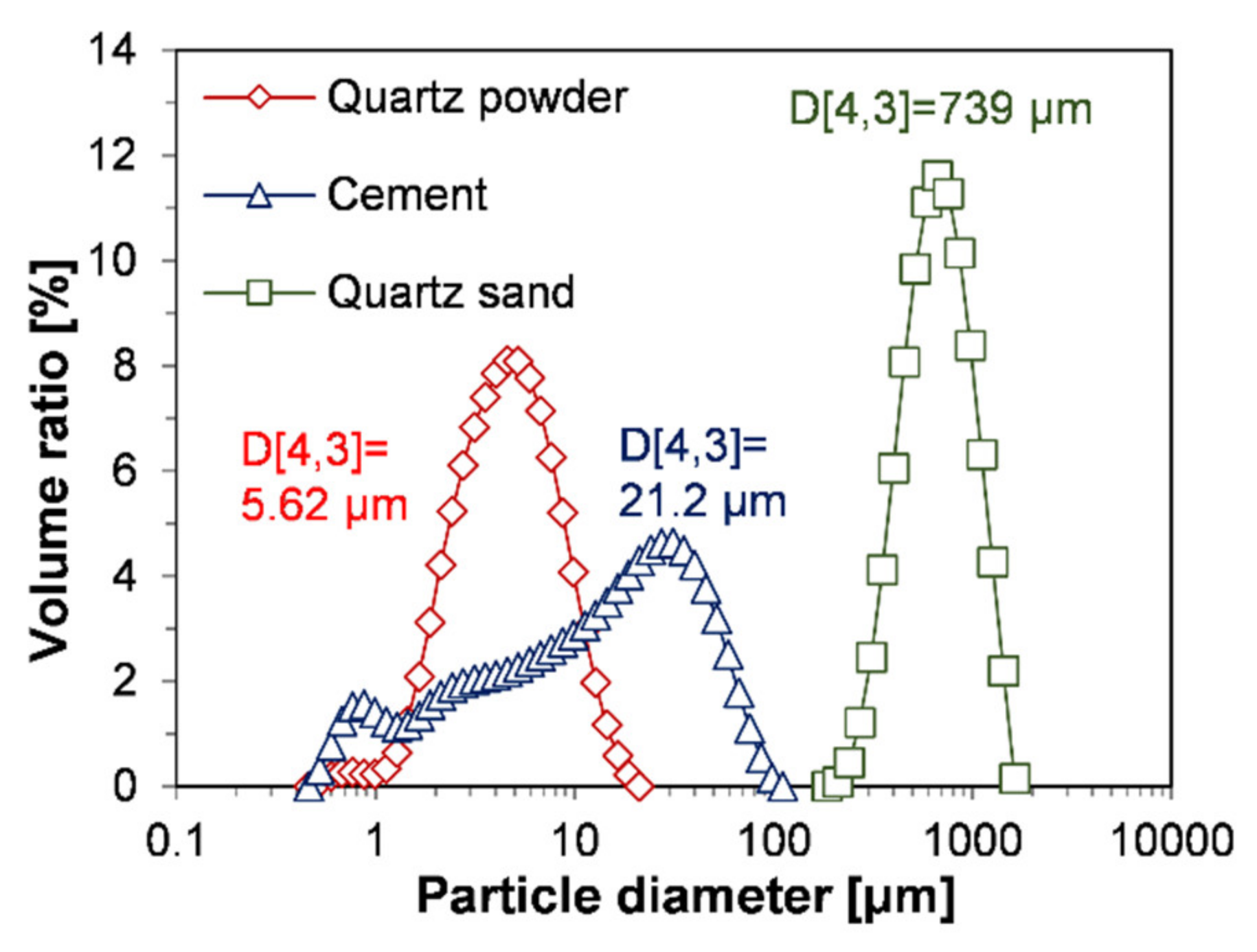


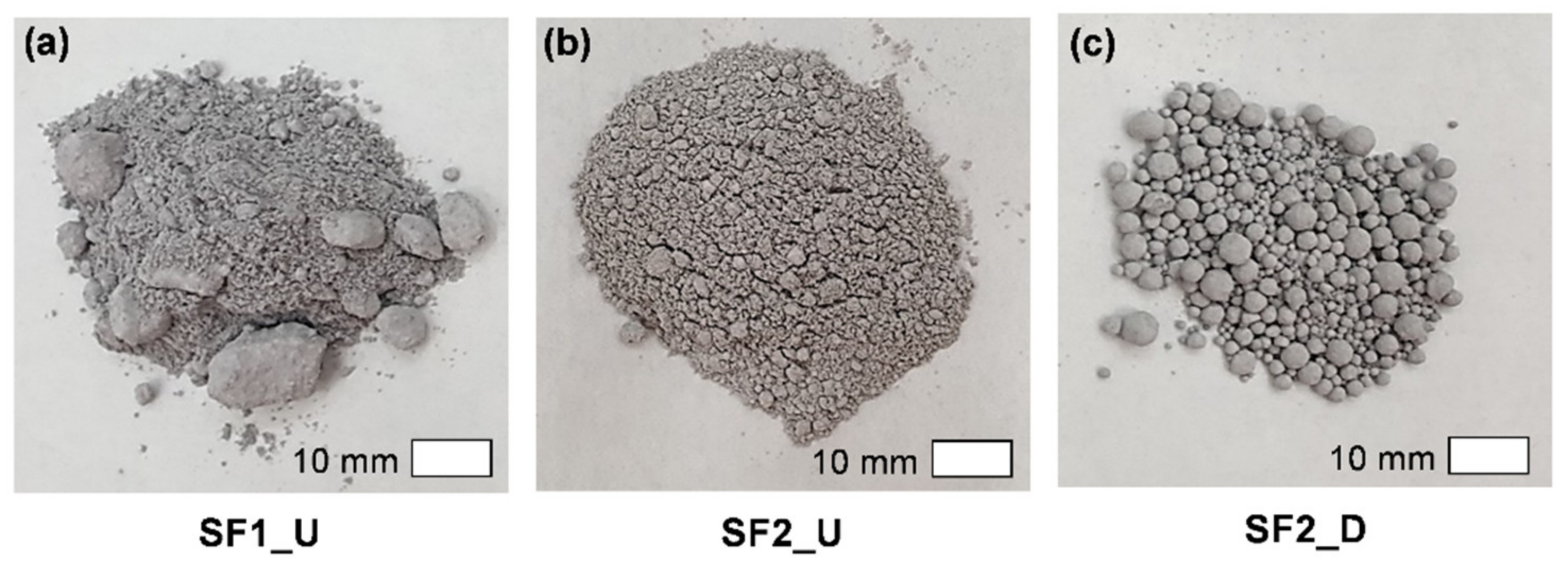
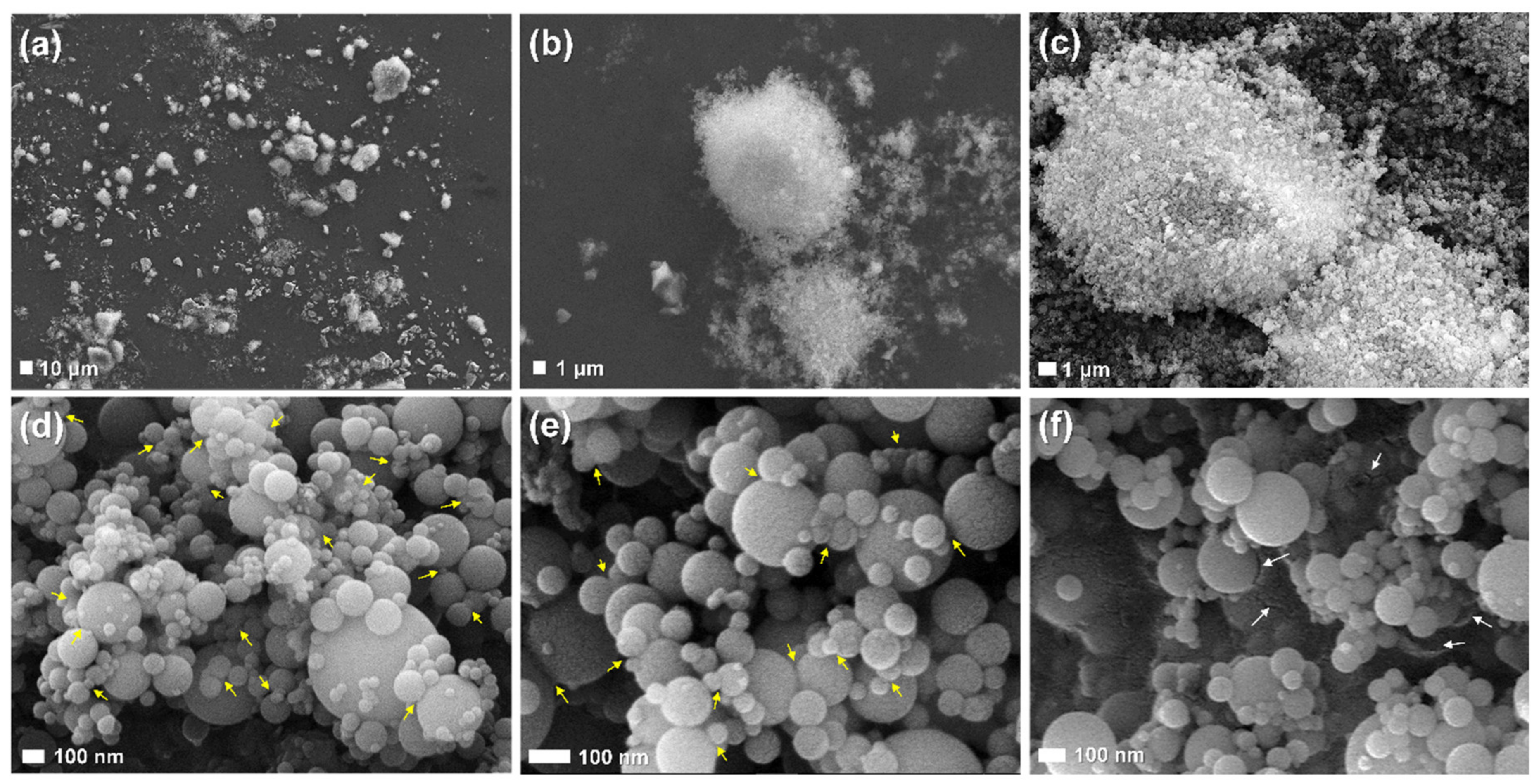

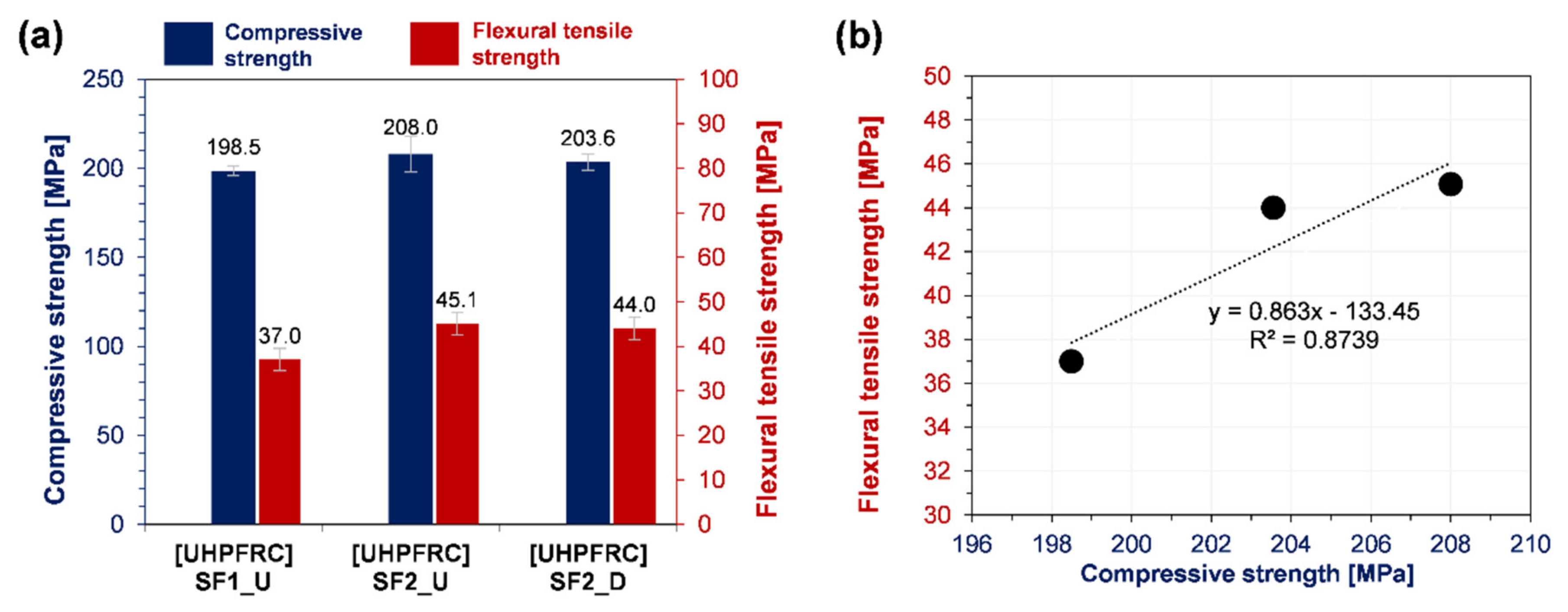
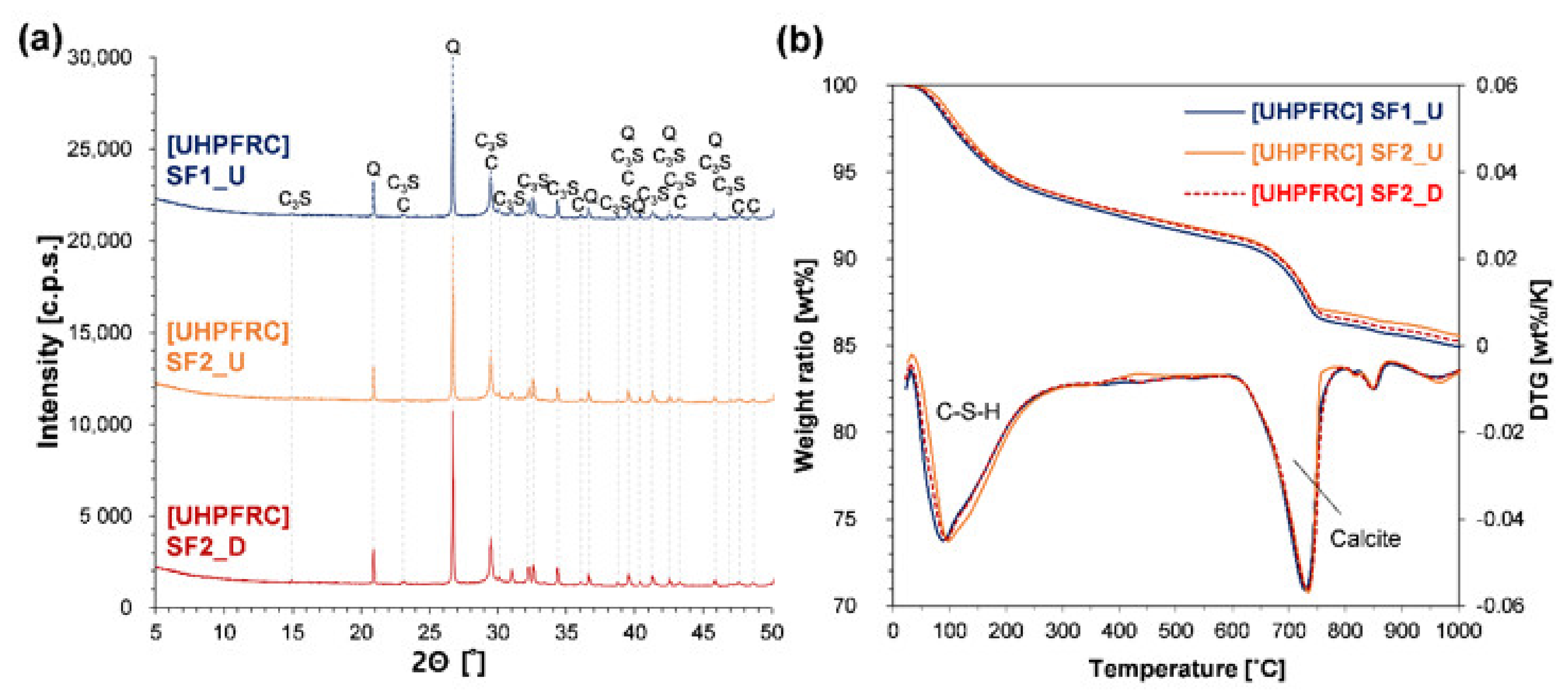
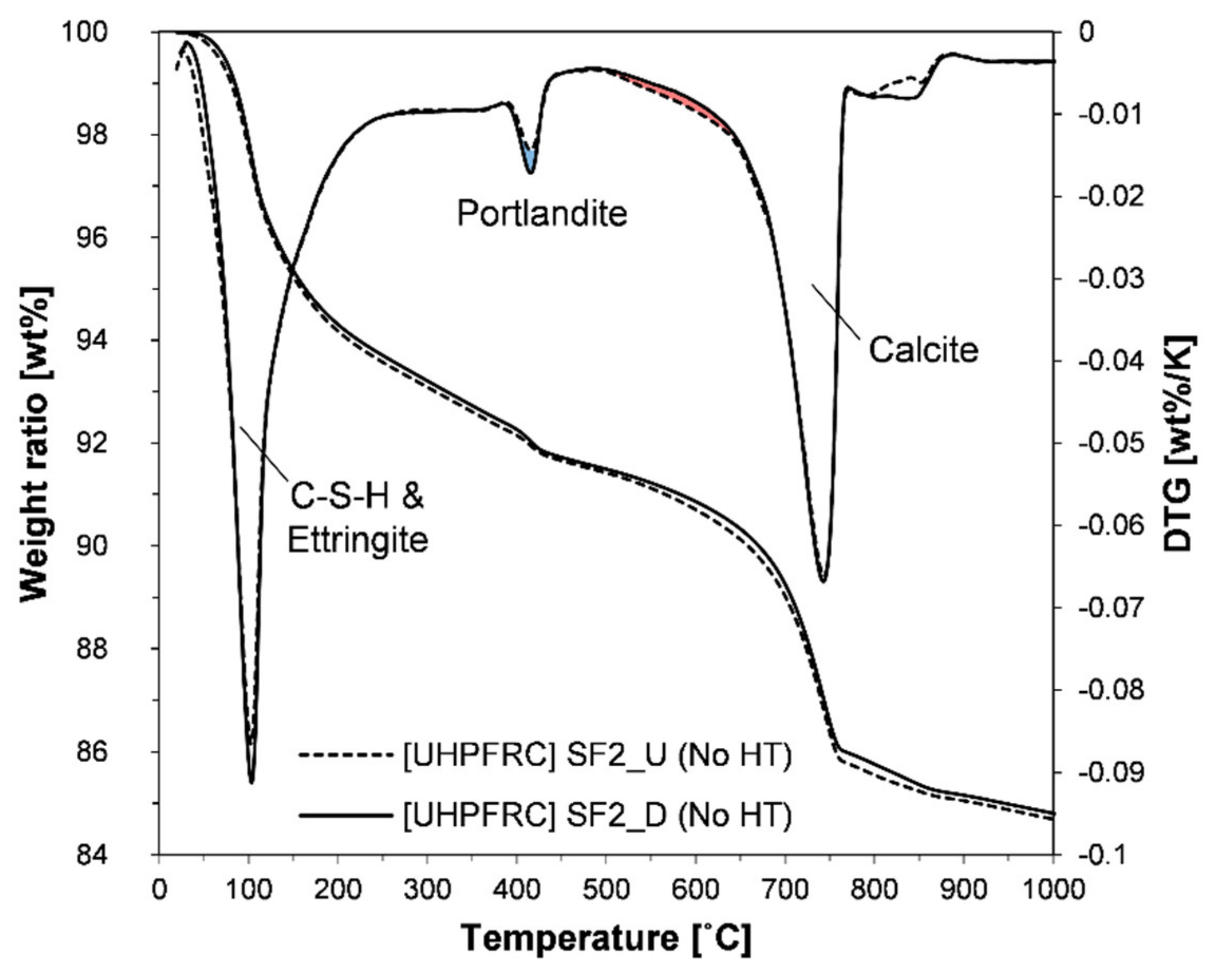
| Sample | SiO2 | K2O | Al2O3 | MgO | CaO | Na2O | SO3 | Fe2O3 | Others 1 | LOI 2 | Total |
|---|---|---|---|---|---|---|---|---|---|---|---|
| SF1_U | 96.00 | 0.83 | 0.72 | 0.40 | 0.27 | 0.26 | 0.19 | 0.10 | 0.20 | 1.00 | 99.98 |
| SF2_U | 96.88 | 0.36 | - | 0.17 | 0.16 | - | 0.46 | 0.53 | 0.09 | 1.36 | 100.00 |
| SF2_D | 96.29 | 0.40 | 0.31 | 0.22 | 0.13 | - | 0.40 | 0.71 | 0.13 | 1.40 | 99.99 |
| Cement | Silica Fume | Quartz Powder | Quartz Sand | Water | Superplasticizer 1 | Steel Fiber 2 |
|---|---|---|---|---|---|---|
| 1 | 0.25 | 0.35 | 1.1 | 0.25 | 0.0012 | 2% |
| Sample Name | SF1_U | SF2_U | SF2_D |
|---|---|---|---|
| Average particle size by DLS (nm) | 440 | 300 | 311 |
| Specific surface area by BET method (m2/g) | 23.8 | 25.3 | 22.9 |
| Sample | Quantitative Analysis by TG (wt %) | Compressive Strength (MPa) | ||||
|---|---|---|---|---|---|---|
| Portlandite | CaO, Portlandite | Calcite | CaO, Calcite | 7 Days | 28 Days | |
| [UHPFRC] SF2_U (No HT) | 0.89 | 0.67 | 10.12 | 5.67 | 117.01 ± 1.38 | 154.01 ± 5.12 |
| [UHPFRC] SF2_D (No HT) | 1.10 | 0.83 | 9.92 | 5.55 | 117.17 ± 2.55 | 154.56 ± 4.02 |
© 2020 by the authors. Licensee MDPI, Basel, Switzerland. This article is an open access article distributed under the terms and conditions of the Creative Commons Attribution (CC BY) license (http://creativecommons.org/licenses/by/4.0/).
Share and Cite
Kang, S.-H.; Hong, S.-G.; Moon, J. Performance Comparison between Densified and Undensified Silica Fume in Ultra-High Performance Fiber-Reinforced Concrete. Materials 2020, 13, 3901. https://doi.org/10.3390/ma13173901
Kang S-H, Hong S-G, Moon J. Performance Comparison between Densified and Undensified Silica Fume in Ultra-High Performance Fiber-Reinforced Concrete. Materials. 2020; 13(17):3901. https://doi.org/10.3390/ma13173901
Chicago/Turabian StyleKang, Sung-Hoon, Sung-Gul Hong, and Juhyuk Moon. 2020. "Performance Comparison between Densified and Undensified Silica Fume in Ultra-High Performance Fiber-Reinforced Concrete" Materials 13, no. 17: 3901. https://doi.org/10.3390/ma13173901
APA StyleKang, S.-H., Hong, S.-G., & Moon, J. (2020). Performance Comparison between Densified and Undensified Silica Fume in Ultra-High Performance Fiber-Reinforced Concrete. Materials, 13(17), 3901. https://doi.org/10.3390/ma13173901





